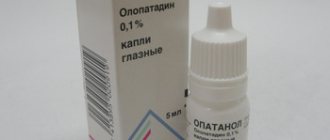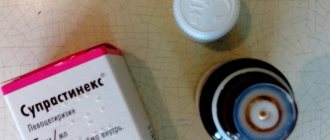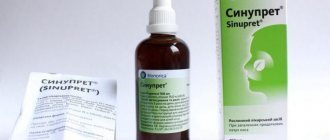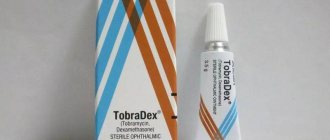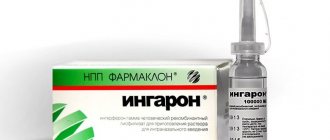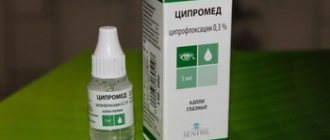Xylometazoline-SOLOpharm drops are prescribed in otorhinolaryngology to relieve nasal congestion and ease breathing. The therapeutic effect is observed due to the vasoconstrictor effect of the main chemical substance of the drug. The active ingredient is the name of the drug, the amount of which varies depending on the percentage of drops produced.
Compound
In 1 ml drops of 0.05% and 0.1% xylometazoline 500 mcg and 1 mg, respectively. Sodium hydrogen phosphate, potassium dihydrogen phosphate, sodium chloride, benzalkonium chloride as auxiliary components.
In 1 ml of spray 0.05% and 0.1% xylometazoline 500 mcg and 1 mg, respectively. Sodium hydrogen phosphate, benzalkonium chloride, disodium edetate dihydrate, potassium dihydrogen phosphate, eucalyptus oil, sodium chloride, macrogol glyceryl hydroxystearate, sorbitol, glycerin, water as auxiliary components.
1 g of xylometazoline gel contains 1 mg. Carbomer, glycerol, ammonia solution, propylene glycol ethanol, methylparaben, propylparaben, water as auxiliary components.
Contraindications
Absolute contraindications:
- arterial hypertension;
- glaucoma;
- severe atherosclerosis;
- tachycardia;
- hyperthyroidism;
- atrophic rhinitis;
- surgical operations on the meninges (history);
- condition after transsphenoidal hypophysectomy;
- combined use with monoamine oxidase inhibitors and tricyclic antidepressants (the interval should be at least 2 weeks);
- age up to 2 years (for drops of 0.05% and spray 35 mcg/dose), up to 6 years (for drops of 0.1% and spray 140 mcg/dose);
- pregnancy;
- increased sensitivity to the components of the drug.
Relative contraindications:
- diabetes;
- coronary heart disease (angina pectoris);
- prostatic hyperplasia;
- pheochromocytoma;
- increased sensitivity to adrenergic drugs (insomnia, dizziness, arrhythmia, tremor, increased blood pressure);
- lactation period.
Pharmacodynamics and pharmacokinetics
Pharmacodynamics
Xylometazoline is an imidazoline derivative. Stimulates α1 and 2-adrenergic receptors of the blood vessels of the nasopharyngeal mucosa. As a result, blood vessels narrow, hyperemia, swelling of the mucous membrane and nasal discharge decrease. As a result, it is easier to breathe through the nose during rhinitis, allergic conditions and diseases of the paranasal sinuses. The spray additionally contains eucalyptus oil, which has anti-inflammatory and antibacterial effects, which has a beneficial effect on reducing swelling of the nasal mucosa. The effect appears after 10-15 minutes and lasts 8-10 hours.
Pharmacokinetics
The pharmacokinetics of the drug have not been studied in humans. Sometimes, when applied topically, absorption is sufficient to produce systemic effects.
Pharmacological properties
Pharmacodynamics
Xylometazoline is a local vasoconstrictor with an α2-adrenomimetic effect. In the short term and for a long time relieves swelling and hyperemia of the nasal mucosa, restoring nasal breathing during rhinitis. When used in recommended doses, xylometazoline does not cause irritation or hyperemia of the mucous membrane. The effect of the drug lasts up to 12 hours.
Pharmacokinetics
When applied topically, xylometazoline is practically not absorbed. Its plasma concentration remains below the detection limit.
Instructions for use of Xylometazoline (Method and dosage)
All forms of the drug are used intranasally.
Xylometazoline nasal drops 0.1% are used in adults, 1-2 drops at each turn three times a day.
The 0.1% spray is used in adults with 1 pump (corresponding to 0.1 mg) per stroke. The applicator is inserted, maintaining the vertical position of the bottle, and injected three times a day after 8-10 hours.
Gel 0.1% is used by adults, 2-3 drops of gel 3 times a day.
Considering the possibility of systemic adsorption and the occurrence of adverse reactions, the instructions for use of Xylometazoline must be strictly followed. Use the drug in any form of release for no more than 3-5 days. Should not be used for a long time or for chronic rhinitis. If crusts appear in the nose, it is better to use the drug in gel form. If a dose is missed, the next dose will not be doubled.
Side effects
- dryness and irritation of the nasopharynx mucosa;
- sneezing;
- tingling;
- increased secretion of nasal discharge;
- allergic reactions;
- swelling of the mucous membrane;
- feeling of heartbeat;
- tachycardia;
- arrhythmia;
- increased blood pressure;
- headache;
- nausea, vomiting;
- visual impairment;
- insomnia;
- depression (with long-term use of high doses of the drug).
It is recommended to inform your doctor if the described side effects worsen or if new ones occur.
Xylometazoline for children
For acute rhinitis in children, it is not advisable to use short-acting vasoconstrictors: Naphazoline, Tetrizoline, Ephedrine, since after their use there is recurrent swelling of the nasal mucosa. It is preferable to use long-acting drugs: Xylometazoline (Dlyanos, Otrivin), Oxymetazoline (Nazivin), Epinephrine (Vibrocil), which allows you to reduce the frequency of use.
Remember that the risk group for poisoning with imidazoline (Xylometazoline) drugs are children under 2 years of age. This drug is not recommended for use in newborns, infants, or children under 2 years of age. In rare cases, if there is no alternative, 0.05% drops are prescribed to children under 2 years of age.
For children over 2 years of age, only a 0.05% concentration of this drug is used, and it is necessary to strictly dose and observe the frequency of use.
From 2 to 6 years 0.05% drops, 1 - 2 drops per turn, twice a day, if necessary, use up to 3 times a day is acceptable. From 6 to 12 years old, you can use 0.05% drops and 0.05% spray, 2-3 drops or one injection at each turn, but no more than 3 times a day.
Children over 7 years old are prescribed 0.05% gel - placed 3-4 times a day deep into each stroke.
From 12 years old, 0.1% drops and spray are used.
It is necessary to take into account that frequent and long-term (more than 5 days, in some authors - more than 3 days) use of this drug can cause a pronounced decrease in local blood flow, as a result of which inadequate blood supply to the mucosa develops, up to its atrophy in the future. In this regard, you should not use the drug in any form of release more than 3 times a day or for more than 3-5 days.
If there is a need to use nasal drops at an earlier age, then Vibrocil is approved for use in children from infancy. In infants, Nazivin 0.01% is also used, from the age of 1 year - Nazivin 0.025%.
special instructions
It is recommended to clean the nasal passages before use. Long-term use of the drug can cause the development of drug-induced rhinitis, as well as atrophy and reactive hyperemia of the nasal mucosa.
Benzalkonium chloride, a preservative in the drug, can cause swelling of the nasal mucosa. In this regard, if signs of congestion appear, it is necessary to replace Xylometazoline-SOLOpharm with a vasoconstrictor drug that does not contain a preservative.
Impact on the ability to drive vehicles and complex mechanisms
During therapy with Xylometazoline-SOLOpharm, care should be taken when driving vehicles and other complex mechanisms that require rapid psychomotor reactions.
Xylometazoline analogues
Analogues: Farmazolin, Farmazolin N, Galazolin, Xylo-mefa, Meralis, Otrivin, Otrivin with menthol and eucalyptus, Tizin Xylo.
Differences between Xylometazoline and Oxymetazoline
Xylometazoline and Oxymetazoline belong to the group of imidazolines, acting on α1 and 2 adrenergic receptors and have a longer effect than drugs of the phenylephrine group: 10 hours of action.
For long-acting drugs, the effect does not occur immediately, but after 10–15 minutes. The long-term vasoconstrictive effect allows them to be used 1-2 times a day, provides restful sleep, but causes a greater risk of damage to the mucous membrane, including atrophy. However, if you do not exceed the period of continuous use (3-4 days), the risk is reduced.
The difference between Xylometazoline and Oxymetazoline is only in the duration of action. Xylometazoline is a drug with an average duration of action of 8-10 hours. Known preparations of xylometazoline: Xylen, Rinostop, Galazolin, Xymelin, Otrivin, Farmazolin, Dlyanos, Tizin-Xylo. Oxymetazoline is a long-acting drug - up to 12 hours. Preparations based on it: Nazivin, Rinazolin, Nazol, Noxprey. To prolong the vasoconstrictor effect, high-molecular prolongators (cellulose ethers, alginates) are added to the composition.
Indications for use of Xylometazoline drops
The product is used to get rid of nasal congestion with:
- acute allergic rhinitis;
- sinusitis;
- rhinopharyngitis;
- viral, bacterial rhinitis;
- hay fever;
- otitis media to reduce swelling of the nasopharyngeal tissues.
Otolaryngologists prescribe the drug to prepare patients for diagnostic procedures in the nasal cavity.
Read more Vizin eye drops: instructions for use, analogues and reviews
Review of effective vasoconstrictor drops
There are many vasoconstrictors that can be used in the treatment of ear diseases. Each of them has its own characteristics and limitations when used for its intended purpose. Therefore, before using any drug from this category of products, it is recommended to consult a specialist and carefully read the instructions for use.
Naphthyzin
This drug is available in the form of drops, the main active ingredient of which is Naphazoline. The main effect of the application is a decrease in swelling of the mucous membranes, which allows expanding the patency of the Eustachian tube and nasopharyngeal canals. It can be used for various inflammatory lesions of the ear apparatus. Among the restrictions in use are:
- hypertension;
- tachycardia;
- atherosclerosis;
- use of antibiotics.
Use in the treatment of children is limited - prior consultation with an otolaryngologist or therapist is required. The most common side effects are:
- irritation of mucous membranes;
- ear pain;
- dizziness;
- nausea and vomiting.
With prolonged use, the development of atrophic rhinitis is possible. The duration of use of Naphthyzin is usually limited to 7-10 days. The drug must be stored in a dark place at temperatures up to 25˚C.
Sanorin
Sanorin has a pronounced vasoconstrictor effect when used in the treatment of various diseases of the nasopharynx and ear apparatus. Its effectiveness lies in the combination of the main active ingredient - Naphazoline with auxiliary components - boric acid and ethyldiamine. The effect occurs within 5 minutes after using the product. It may be prescribed if necessary to treat acute otitis media and Eustachian tube dysfunction. The following are usually indicated as contraindications for use:
- chronic rhinitis and sinusitis;
- perforation damage to the eardrum;
- pronounced atherosclerotic disorders;
- severe eye diseases;
- diabetes mellitus types 1-2;
- tachycardia and hypertension;
- use of antibiotics.
Release form and packaging
The drug is available in three forms:
- Nasal drops.
- Spray.
- Gel (ointment).
Vasoconstrictor nasal drops contain a 0.05% or 0.1% solution of Xylometazoline, in this form they are a yellowish or colorless liquid. The drug is produced in bottles of 10, 15, 20 or 30 ml. The container is equipped with a special dispenser for convenient instillation without using a pipette. Nasal drops are used to treat adults and children over 6 years of age.
The intranasal spray contains a 0.1 or 0.05 percent solution of Xylometazoline. Bottles with a volume of 20 or 10 ml are equipped with a dispenser nozzle. Thanks to the nozzle, the spray is evenly distributed over the surface of the mucous membrane, thereby having a more pronounced effect.
Xylometazoline ointment (gel) is a liquid of viscous consistency, colorless and odorless. This release form contains 5 g of a mixture of Xylometazoline at a concentration of 0.05% or 0.1%. The undeniable advantage of the ointment is its prolonged action (about 10 hours). Unlike drops and sprays, which quickly disappear from the surface of the nasal mucosa, the gel lingers inside for a longer time.
This gel is recommended for removing and softening dry crusts that have formed in the nose. Xylometazoline is available in 10 mm bottles called Galazolin (manufactured in Poland). Due to the high concentration of the active component, the gel is not recommended for use in children under one year of age.
Overdose
If you use the drug beyond the specified period in the instructions, systematically exceed the permissible number of drops per day, an overdose may result in side effects of varying severity. If you accidentally drink, an overdose may occur:
- dilated pupils;
- bluish coloration of the skin;
- nausea;
- vomiting;
- fever;
- disturbances in heart rhythm and breathing;
- rise in blood pressure;
- mental disorders;
- pulmonary edema.
Read more Sulfacyl sodium eye drops - instructions for use
The appearance of drowsiness, bradycardia, respiratory failure, fainting, coma indicates inhibition of the function of the central nervous system under the influence of the active substance Xylometazoline drops.
After taking the medicine orally, call an ambulance. Before her arrival, induce vomiting and take a sorbent (activated carbon, Polysorb or others). Treatment in a hospital: gastric lavage, symptomatic treatment, in case of coma - hospitalization in the intensive care unit.
Prevention
In order to reduce the risks of diseases of the ear apparatus with severe swelling of the mucous tissues, it is necessary to follow certain rules. The main prevention method is as follows:
- Timely treatment of inflammatory diseases, especially those with symptoms of runny nose and stuffy ears.
- Regular walks in the fresh air and daily ventilation of the living space.
- Consumption of foods rich in vitamins and minerals;
- Avoiding places with large crowds of people during periods of seasonal diseases;
- Using preventive medications to strengthen the immune system and treat the nose and ears.
If there are chronic diseases of the ear apparatus, it is recommended to undergo regular preventive examinations and follow all instructions of the treating specialist.
The use of vasoconstrictor drops in the treatment of ear diseases has its own limitations and characteristics. Such drops can be used only after a direct prescription from a specialist, completely following the indicated administration method - this will reduce the possibility of side effects and secondary pathologies.

